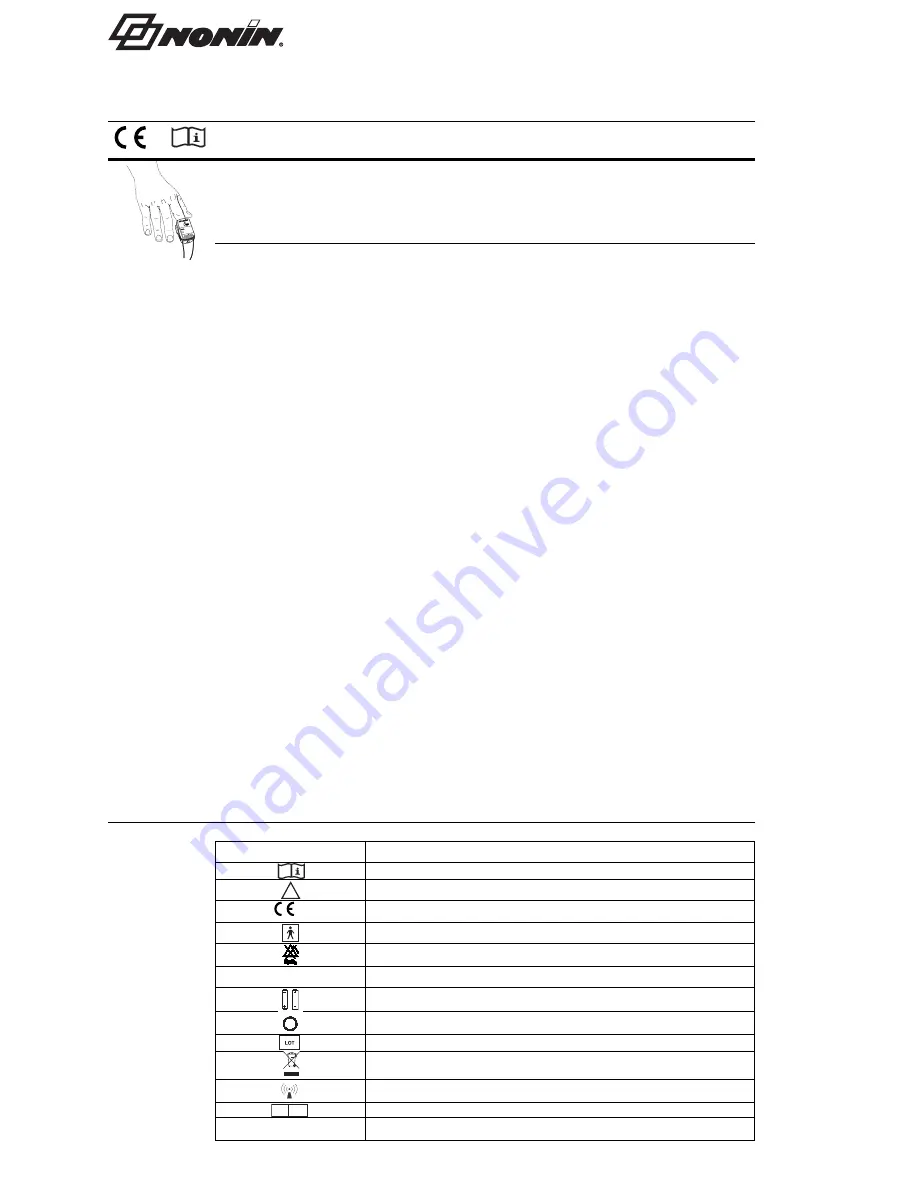
Instructions for Use
Onyx
®
9500 Finger Pulse Oximeter
Indications for Use
The NONIN
®
Onyx
®
Model 9500 Finger Pulse Oximeter is a small, lightweight, portable device indicated for use in measuring
and displaying functional oxygen saturation of arterial hemoglobin (%SpO
2
) and pulse rate of patients who are well or poorly
perfused. It is intended for spot-checking of adult and pediatric patients on fingers (other than the thumb) between 0.3 - 1.0 inch
(0.8 – 2.5 cm) thick.
Caution: Federal law (USA) restricts this device to sale by or on the order of a licensed practitioner.
Contraindications
•
Do not use this device in an MRI environment, in an explosive atmosphere, or on infant or neonatal patients.
•
This device is not defibrillation proof per IEC 60601-1:1990 clause 17h.
Warnings
•
This device is intended only as an adjunct in patient assessment. It must be used in conjunction with other methods of
assessing clinical signs and symptoms.
•
The device must be able to measure the pulse properly to obtain an accurate SpO
2
measurement. Verify that nothing is
hindering the pulse measurement before relying on the SpO
2
measurement.
•
Operation of this device below the minimum amplitude of 0.3% modulation may cause inaccurate results.
•
General operation of the device may be affected by the use of an electrosurgical unit (ESU).
•
The use of accessories other than those specified in these instructions may result in increased electromagnetic emission
and/or decreased immunity of this device.
•
This device should not be used adjacent to or stacked with other equipment. If adjacent or stacked use is necessary, the
device should be observed carefully to verify normal operation.
Cautions
•
This device is designed to determine the percentage of arterial oxygen saturation of functional hemoglobin. Significant levels
of dysfunctional hemoglobin may affect measurement accuracy.
•
This device has no audible alarms and is intended only for spot-checking.
•
Inspect the sensor application site at least every 6 to 8 hours to ensure correct sensor alignment and skin integrity. Patient
sensitivity to sensors may vary due to medical status or skin condition.
•
Fluctuating or very bright light, moisture, blood pressure cuffs, infusion lines, venous pulsations, insufficient pulse signals,
anemia, arterial catheters, nail polish, and/or artificial nails may degrade the device’s performance.
•
The device may not work when circulation is reduced. Warm or rub the finger, or re-position the device.
•
This device’s display will go blank after 30 seconds of no readings or poor readings.
•
In some circumstances, the device may interpret motion as good pulse quality. Minimize patient motion as much as possible.
•
Cardiogreen and other intravascular dyes may affect the accuracy of the SpO
2
measurement.
•
Do not autoclave or immerse this device in liquid or use caustic or abrasive cleaning agents.
•
A flexible circuit connects the two halves. Do not twist or pull the flexible circuit or overextend the device’s spring.
•
Do not hang the lanyard from the device’s flexible circuit/strain relief.
•
A functional tester cannot be used to assess the accuracy of a pulse oximeter monitor or sensor.
•
This equipment complies with IEC 60601-1-2:2001 for electromagnetic compatibility for medical electrical equipment and/
or systems. This standard is designed to provide reasonable protection against harmful interference in a typical medical
installation. However, because of the proliferation of radio-frequency transmitting equipment and other sources of electrical
noise in healthcare and other environments, it is possible that high levels of such interference due to close proximity or
strength of a source might disrupt the performance of this device. Medical electrical equipment needs special precautions
regarding EMC, and all equipment must be installed and put into service according to the EMC information specified in this
manual.
•
Portable and mobile RF communications equipment can affect medical electrical equipment.
•
Batteries may leak or explode if used or disposed of improperly. Remove batteries if the device will be stored for more than
30 days. Do not use different types of batteries at the same time. Do not mix fully charged and partially charged batteries
at the same time. These actions may cause the batteries to leak.
•
Follow local, state and national governing ordinances and recycling instructions regarding disposal or recycling of the device
and device components, including batteries.
•
In compliance with the European Directive on Waste Electrical and Electronic Equipment (WEEE) 2002/96/EC, do not
dispose of this product as unsorted municipal waste. This device contains WEEE materials; please contact your distributor
regarding take-back or recycling of the device. If you are unsure how to reach your distributor, please call NONIN
®
for your
distributor’s contact information.
Symbols
Symbol
Definition of Symbol
Consult Instructions for Use
Caution
CE Marking indicating conformance to EC Directive No. 93/42/EEC concerning medical
devices
Type BF Applied Part (patient isolation from electrical shock)
Not for Continuous Monitoring (no alarm for SpO
2
)
SN
Serial Number
Battery Orientation
UL Mark for Canada and the United States with respect to electric shock, fire, and mechanical
hazards only in accordance with UL 60601-1 and CAN/CSA C22.2 No. 601.1
Lot Number
Indicates separate collection for electrical and electronic equipment (WEEE).
Non-ionizing electromagnetic radiation. Equipment includes RF transmitters.
Interference may occur in the vicinity of equipment marked with this symbol.
Authorized Representative in the European Community.
IPX2
Protected against vertically falling water drops when enclosure is tilted up to 15 degrees,
per IEC 60529.
0123
'&
%&
!
0123
CL
ASSIFIED
US
C
UL
EC
REP





